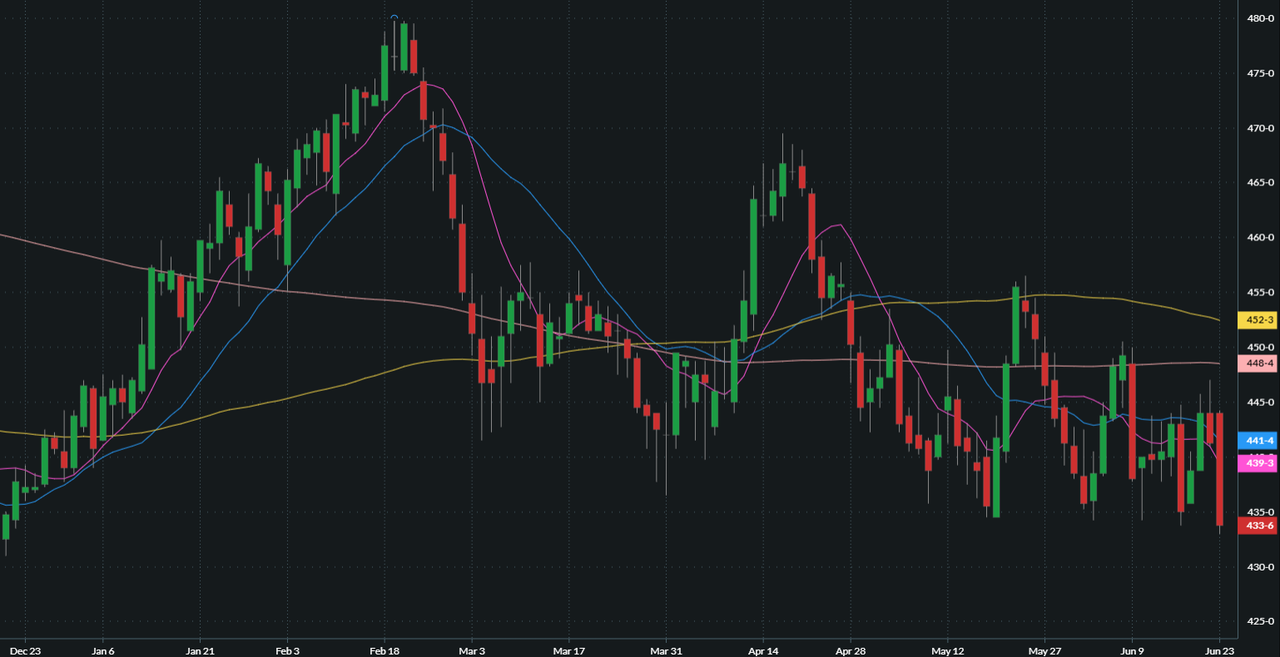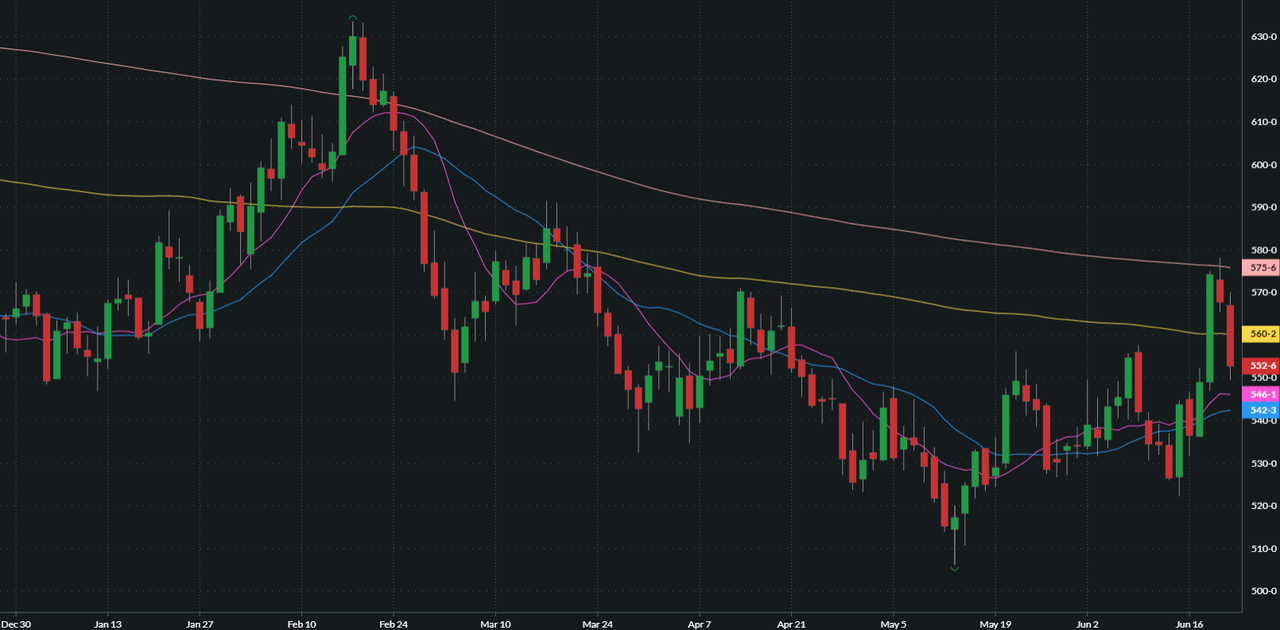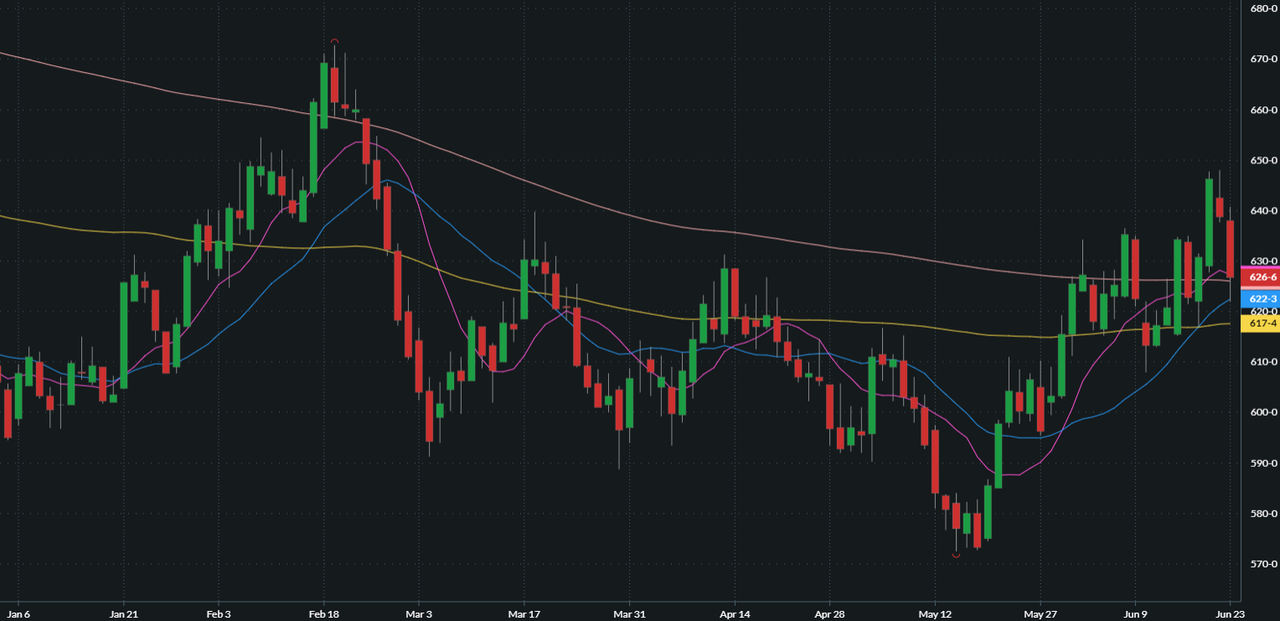Don’t miss the latest market commentary from the Farm Futures team. Sign up for the complimentary morning and afternoon market newsletters!
Prices updated as of 6:55 a.m. CDT.
What we’re watching
Anyone who’s traded call or put options is likely familiar with the concept of time value decay, meaning these instruments lose value as expiration nears. This makes options a bit like musical chairs, Farm Futures Contributing Analyst Bryce Knorr says. In his latest Ag Marketing IQ column, Bryce walks through a few need-to-knows before the music stops.
Corn burdened by bearish weather
July corn futures fell 2.5 cents to $4.1675 per bushel late in overnight trading after earlier dropping to $4.1625, the contract’s lowest intraday price since $4.2925 on June 10. December corn fell 2.5 cents to $4.3125 after sinking 7.5 cents Monday to $4.3375, the new-crop contract’s lowest settlement since December 18.
The corn market’s dismal technical performance continued into a new week, with December futures sinking overnight to $4.3150, which means a test of the $4.28 contract low, set in November, could be in the offing. July futures are nearing oversold territory but that’s not the case with the December contract, which currently registers just under 46 on the Relative Strength Index.
Speculators are ramping up bearish bets, with the managed money net short position in corn futures expanding three weeks in a row to its greatest level since early September. There appears to be little standing in the way of further price downside unless USDA’s June 30 acreage update reveals a surprisingly low corn number.
Barchart’s front-month national average cash corn price fell about 8.75 cents Monday to $3.9625, its first drop under $4 since late November.

Crude oil futures extended Monday’s steep losses following reports Israel agreed to U.S. Donald Trump's proposal for a ceasefire with Iran, easing concern potential energy supply disruptions in the Middle East.
Otherwise, grain market focus largely remains on bearish Midwest weather, with extreme heat still gripping much of the region but abundant rainfall also expected for Iowa and other top corn states this week. The favorable weather outlook enabled traders to shrug off an unexpected decline in weekly crop ratings.
USDA reported 70% of the U.S. corn crop was in either “good” or “excellent” condition as of Sunday, down from 70% a week earlier but up from 69% a year earlier. Analysts expected the good-to-excellent figure to hold steady. Monday’s number ended a three-week string of improvement in the good-to-excellent number.
Among top producing states, Iowa’s crop slipped to 83% good-to-excellent from 84% a week earlier, while Ohio improved to 60% good-to-excellent from 58%. The overall crop was 97% emerged as of Sunday, up from 94% a week earlier and slightly under the 98% average for the previous five years. Ohio improved to 92% emerged from 86% a week earlier.
Also Monday, USDA reported corn inspected for export at 1.477 million metric tons (58.1 million bushels) during the week ended June 19, down 13% from the previous week but up 28% from the same week in 2024. Mexico was again the top destination at 345,857 MT, followed by Japan at 249,885 MT.
For 2024-25 to date, shipments now total 2.108 billion bushels, up 28.5% from the same period in 2023-24 and 79.5% of USDA’s 2.65-billion-bushel forecast for the full year (the current marketing year for corn and soybeans ends August 31). Shipments are exceeding the seasonal pace needed to hit USDA’s full-year export target by about 134 million bushels, StoneX analyst Arlan Suderman noted.
Mexico’s continued buying reflects the U.S. recently halting the country’s cattle imports to contain an outbreak of New World screwworm.
“The inability of Mexico to ship 30,000 head of feeder cattle north into the United States each week to fill our feedlots due to the New World screwworm means that (Mexico) needs more corn to feed those cattle down there,” Suderman wrote.
Elsewhere Monday, private consultant AgRural reported harvest of Brazil’s 2025 second corn crop, also known as the safrinha, was 13% complete as of last Thursday, up from 5.2% the previous week but below 34% on the comparable week last season.
The U.S. “is starting to cede some of its primacy in the export market to Brazil,” StoneX analyst Bevan Everett said in a note, adding that Brazil’s spot corn market is undercutting the U.S. by about 20 cents per bushel.
Soybean crop ratings hold steady
July soybeans fell 4.25 cents to $10.5450 late in overnight trading after earlier sinking to $10.5150, the contract’s lowest intraday price since June 13. November soybeans fell 6.75 cents to $10.40 after earlier falling to $10.3850, the new-crop contract’s lowest intraday price since June 13.
November futures’ technical posture continues to erode after last Friday’s bearish outside day lower on the daily bar chart was followed by further weakness early this week. The new-crop contract on Monday closed under the 10-day simple moving average, currently $10.4850, for the first time since June 12, and overnight pushed under the 20-day SMA around $10.40. Key support comes in at the 200- and 100-day SMAs, which coincide at $10.34 to $10.33.
Failure of near-term support levels could set up a test of the June intraday low of $10.1525, posted June 3.
Barchart’s national front-month cash soybean price fell about 9.25 cents Monday to $10.11.

July soybean meal rose 10 cents to $282.50 per ton after losing 0.6% Monday and posting a contract low for the fourth day in the past five. July soybean oil fell 124 points to 52.00 cents per pound after plunging 2.3% Monday in a continued pullback from 18-month highs.
Soybeans remain under pressure from bearish Midwest weather and sharp crude oil declines that have sent soyoil futures tumbling from a recent rally. Traders appeared unbothered by weekly USDA crop ratings that also fell short of expectations.
Late Monday, USDA reported its 18-state combined good-to-excellent rating was 66% as of Sunday, unchanged from the previous week and below the 67% year-earlier level. Analysts expected the good-to-excellent figure to improve one percentage point.
Iowa’s good-to-excellent rating fell to 77% from 80% a week earlier, while Ohio improved to 57% from 54%. Overall, the U.S. crop was 96% as of Sunday, up from 93% a week earlier but under the 97% five-year average. About 90% of the crop had emerged, up from 84% a week earlier and even with the five-year average.
U.S. soybean export commitments for the upcoming 2025-26 marketing year picked up recently but continue to lag last year’s pace, while near-term demand has also sagged with global buyers turning to bountiful South American supplies.
USDA reported weekly soybean export inspections at 192,890 MT (7.09 million bushels), down almost 14% from the previous week, down 45% from the same week last year and a marketing-year low. Germany was the week’s top buyer at 63,382 MT, followed by Mexico at 55,883 MT.
For 2024-25 to date, soybean shipments now total 1.676 billion bushels, 10.6% above the same period in 2023-24 and 90.6% of USDA’s full-year export forecast of 1.85 billion bushels with a little over two months left in the current crop year.
Inspections have been exceeding the seasonal pace needed to hit USDA’s export target by about 71 million bushels, Suderman said “Yet, that gap has been shrinking in recent weeks as Brazil continues to dominate the global market with cheaper supplies,” the analyst added.
Wheat fades even as crop deteriorates
July SRW wheat futures fell 11.25 cents to $5.4150 late overnight after plunging 15 cents Monday to $5.5275 as the market extended a pullback from a three-month high posted Friday.
The wheat market’s failure to build on last week’s brief rally to three-month highs bodes poorly for bulls, and while funds have pared back bearish bets in recent weeks, there appears to be little fundamental case for an extended short covering upswing. In July SRW futures, a close below the 10- and 20-day SMAs ($5.4650 and $5.4250) would further sour the technical picture. Other downside levels to watch include last week’s July SRW low at $5.4525.

July HRW futures fell 10.75 cents to $5.3925 after dropping 13.25 cents Monday to $5.50. July spring wheat fell 4 cents to $6.2275 after losing 12 cents Monday.
The wheat market’s recent rally, driven in part by escalating Middle East tensions that sent oil prices soaring, quickly lost steam amid expectations for a stronger winter wheat crop and a lack of concern over supplies.
Weekly winter wheat ratings unexpectedly deteriorated, indicating recent heavy rains that have impeded the Plains harvest may also be hurting crop quality.
USDA’s 18-state combined good-to-excellent rating fell to 49% as of Sunday, down from 52% a week earlier and marking the second consecutive weekly decline. The good-to-excellent rating was 52% a year ago. Analysts expected the reading to hold unchanged.
Kansas’ good-to-excellent rating slumped to 45% from 49% a week earlier. Harvest was 19% complete as of Sunday, up from 10% a week earlier but behind the 28% five-year average for that date. Texas again led the way with 70% of the state’s crop harvested, while Kansas was at 20%.
Spring wheat conditions also eroded, with the crop’s good-to-excellent rating dropping to 54% from 57% a week earlier and also down from 71% a year earlier.
Disappointing export numbers also weighed on wheat prices. USDA reported wheat inspected for export at 254,782 MT (9.36 million bushels) during the week ending June 19, down 34% from the previous week and 26% below the same week last year. Japan and Mexico were the week’s top destinations at 80,169 MT and 65,970 MT, respectively.
For 2025-26 to date, wheat shipments now total 31 million bushels, 20% below the same period in 2024-25 and 3.8% of USDA’s full-year export forecast of 825 million bushels.
Elsewhere, Europe’s crop monitoring service MARS raised its 2025 European Union soft wheat yield estimate from 6.04 to 6.05 metric tons per hectare (89.8 to 90 bushels per acre), up 5% from the five-year average. Estimated corn yields rose from 7.45 to 7.46 MT per hectare (118.7 to 118.9 bushels per acre), also 5% above the five-year average.
Argus Media raised its 2025-26 Russian wheat production estimate to 84.8 MMT (3.12 billion bushels) from 80.3 MMT in March following a crop tour earlier this month. The projected crop would also be up from 81.3 MMT last year. Better yields are seen making up for a slight year-over-year decline in harvested area.


Heavy rains heading for parts of Midwest
The Midwest faces more extreme heat over the next few days along with thunderstorms and potentially heavy rains for the central part of the region. Heaviest rains are seen for a band stretching from eastern Nebraska through western Iowa and southern Minnesota, which totals could range from 1.5 inches to over 3 inches, based on the latest 72-hour cumulative precipitation map from NOAA. Lighter rains are expected for the eastern Corn Belt.
Warmer-than-normal temperatures and above-normal precipitation prospects are expected the remainder of this month, though the heat may moderate during the first week of July, based on the National Weather Service’s 6-to-10 and 8-to-14-day outlooks, which cover June 29-July 7.
Stock futures firmer on Israel-Iran truce
Stock index futures climbed overnight after President Trump announced a ceasefire between Israel and Iran, easing investor concerns that an expanding Middle East conflict could disrupt oil supplies and the global economy.
Futures based on the S&P 500 and the Nasdaq-100 indexes rose 0.5% and 0.8%, respectively, while futures based on the Dow industrials rose 0.4%. The U.S. dollar index fell 0.4% and is poised for a second daily decline, near a three-year low posted earlier this month.
August WTI crude oil futures plunged over 3% to $66.33 per barrel after earlier rallying Monday above $78 to a five-month high.
What else I’m reading at www.FarmFutures.com this morning:
- What happens in cornfields that yield over 250 bushels per acre that doesn’t happen in those that yield sub-150? Research indicates there are four key factors that set high-yielding corn apart, according to Midwest Crops Editor Tom J. Bechman.